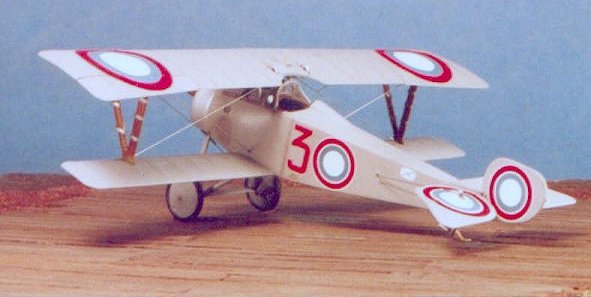
Eduard 1/48 Nieuport 21
|
KIT # |
|
|
PRICE: |
$29.95 |
|
DECALS: |
Four aircraft |
|
REVIEWER: |
|
|
NOTES: |
Profipack version |

|
HISTORY |
The Nieuport 21 was conceived as an advanced trainer for the French air service. Some aircraft were delivered to combat units but overall the type was used primarily as a training aircraft from 1916 on by the French and the Royal Naval Air Services, and later the U.S. Army air Service in 1918. Light and nimble, they were ideal for giving a pilot “the feel” for a more powerful airplane without risking a frontline N17 with a novice fighter pilot. The French Navy used the Nie. 21 for experiments in taking off from battleships in the early 1920s.
The Imperial Russian Air Service is the only air service known to use the Nieuport 21 as a front line combat aircraft. Some aircraft were supplied by France and 68 were built under license in Russia. The Nie. 21 was used in Russia on active service until 1925.
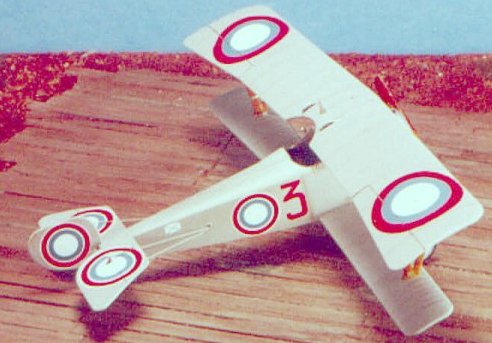 I decided to
build my kit as the aircraft flown by the Russian ace , Alexander de Seversky.
Seversky was a natural born pilot and could fly his father’s Farman biplane by
the time he was 14 years old. He graduated from the Imperial Russian Naval
Academy and was serving at sea when the First World War began. He requested a
transfer to the aviation branch where he was shot down while attacking a German
destroyer. In the ensuing explosion, he lost his leg. Seversky was deemed
unfit for service but the Czar personally intervened in his case and he resumed
active flying in 1916. The one-legged pilot went on to shoot down 6 enemy
planes before he was assigned as a Naval attaché in the United States in
1918. He never returned to Russia due to the overthrow of the Czar and the
establishment of the Soviet Union in 1918.
I decided to
build my kit as the aircraft flown by the Russian ace , Alexander de Seversky.
Seversky was a natural born pilot and could fly his father’s Farman biplane by
the time he was 14 years old. He graduated from the Imperial Russian Naval
Academy and was serving at sea when the First World War began. He requested a
transfer to the aviation branch where he was shot down while attacking a German
destroyer. In the ensuing explosion, he lost his leg. Seversky was deemed
unfit for service but the Czar personally intervened in his case and he resumed
active flying in 1916. The one-legged pilot went on to shoot down 6 enemy
planes before he was assigned as a Naval attaché in the United States in
1918. He never returned to Russia due to the overthrow of the Czar and the
establishment of the Soviet Union in 1918.
Seversky became an American citizen and founded Seversky Aircraft Company which, in 1939 became Republic Aviation. Seversky's SEV-1 was one of the most advanced aircraft of the 1930s, and was later developed into the P-35, as well as a series of racers that won international acclaim when flown by such pilots as Jacqueline Cochran. Seversky and his chief designer Alexander Kartveli were responsible for developing what became the P-47 Thunderbolt of World War II fame. He died in 1974.
|
THE KIT |
The only models I have ever built are WW1 aircraft. As a whole, the kits representing aircraft of that era have a reputation for being difficult to build. The rigging is often difficult to master, and the overall structure is usually weak given all the wing struts.. Given all these “drawbacks” many modelers just say “Why Bother?”. But we have all been to model shows where that rare, well made biplane model just looks so darn cool, especially after seeing umpteen versions of the latest Hasegawa thingamiggier.
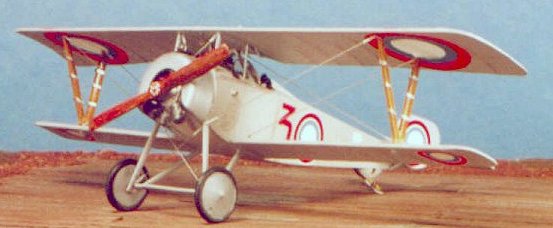 The Nieuport
21 is the latest in a line of 1/48 Nieuport offerings from Eduard. It is
essentially a Nieuport 17 profipack kit with a 80 h.p. LeRhone and a Nieuport 11
cowling in lieu of the 110 hp engine and full cowling on the Nieuport 17. The
kit consists of 39 superbly molded plastic parts, one clear plastic windscreen,
and Eduard’s photo-etch for the Profi-pack. Parts and decals are included to
build 4 distinct aircraft, including a Russian version on skis.
The Nieuport
21 is the latest in a line of 1/48 Nieuport offerings from Eduard. It is
essentially a Nieuport 17 profipack kit with a 80 h.p. LeRhone and a Nieuport 11
cowling in lieu of the 110 hp engine and full cowling on the Nieuport 17. The
kit consists of 39 superbly molded plastic parts, one clear plastic windscreen,
and Eduard’s photo-etch for the Profi-pack. Parts and decals are included to
build 4 distinct aircraft, including a Russian version on skis.
Like all new Eduard releases the molded plastic parts are crisp, highly detailed, and almost devoid of any flash. What flash there is can be seen only when held up to the light at an angle. The instructions are the typical Eduard exploded view without explanatory text. Each of the 4 aircraft possible to build from this kit have distinct “mini-windows” in the instructions showing which parts to use and how to assemble for the chosen model.
|
CONSTRUCTION |
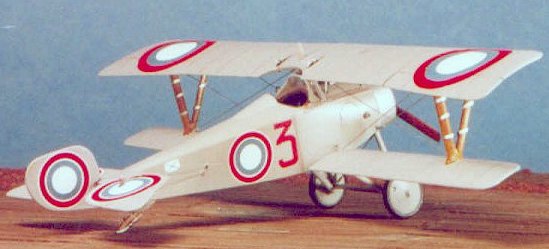 All I can say
is “slammer!" I had no trouble putting this kit together but I did spend some
time studying the instructions before I started. For instance, for Seversky’s
aircraft (marking D), a small part is to be inserted through the top wing. It
is much easier to install this before painting the top wing! Another “catch”
was in the decaling. Russian aircraft were covered with roundels everywhere. I
had to take an assembly apart when I didn’t notice I needed to decal first.
All I can say
is “slammer!" I had no trouble putting this kit together but I did spend some
time studying the instructions before I started. For instance, for Seversky’s
aircraft (marking D), a small part is to be inserted through the top wing. It
is much easier to install this before painting the top wing! Another “catch”
was in the decaling. Russian aircraft were covered with roundels everywhere. I
had to take an assembly apart when I didn’t notice I needed to decal first.
A problem point for most WW1 modelers is mounting the top wing. This is one of the easiest kits to get a good mount and alignment on. I mounted the cabanes to the fuselage and ensured proper spacing with my calipers. I mounted the struts to the upper wing. When all are dry, the top wing just about snap into place!
|
PAINT & DECALS |
Painting:
I painted my N21 to represent Seversky’s aircraft of October 1917. I used Tamiya or Gunze arcylics overall. The overall aircraft is painted using Tamiya XF-14 Sky Grey. Aluminum portions other than the engine cowling is done with Tamiya Flat Aluminum XF-16. The cowling is done with SnJ metalizer and polished.
Struts, tail skid, and prop are done in wood grain. I am still experimenting with acquiring a good wood grain effect on plastic. This go around I used Gunze Sail (H85) as a base coat with Gunze Cocoa Brown (H17) lightly brushed over to get a grain effect. Not bad, but I still have a lot to learn.
 I also
experimented with pastel chalks this time in accenting the wing rib detail. I
used a Rembrant soft pastel called Mars Violet in this effort. I just rub some
onto a piece of white paper, take a tiny bit up on a brush, and dry brush it
gently where I want it. The effect is very subtle and it is easy to take way
too much color up on the brush. Nice!
I also
experimented with pastel chalks this time in accenting the wing rib detail. I
used a Rembrant soft pastel called Mars Violet in this effort. I just rub some
onto a piece of white paper, take a tiny bit up on a brush, and dry brush it
gently where I want it. The effect is very subtle and it is easy to take way
too much color up on the brush. Nice!
Decals.
Decals are provided for 4 different airplanes, 3 Russian and one French aircraft in the markings of Raoul Lufbery. The decals are the typical outstanding Eduard quality. They go on smooth and lay down snug!
Rigging.
This is a very easy model to rig, and rigging makes a WW1 model look WW1! I use .007” stiff wire to rig this airplane. The turnbuckles are .009” teflon tubing from Small Parts, Inc. Each wire is set into into place with white glue. The length each piece of rigging is adjusted by adjusting the teflon tubing.
|
CONCLUSIONS |
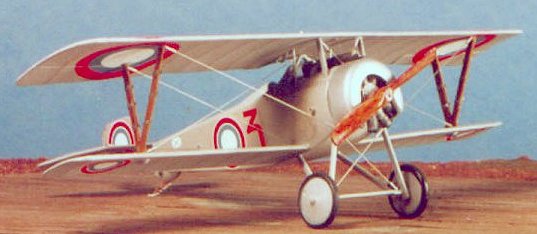 A nice kit that
can’t but help to turn into a nice model with the usual bit of patience. As
usual, superb Eduard quality all around. The oft heard reasons to avoid
biplane models just don’t hold water ever since Eduard started to release their
full production line of WW1 aircraft. The latest release, the Nieuport 21, is
as close to an out of the box “slammer” as I have ever seen. With just a bit of
moxie to tackle a biplane, you will be surprised at what a beautiful model can
be yours. These kits are beautiful!
A nice kit that
can’t but help to turn into a nice model with the usual bit of patience. As
usual, superb Eduard quality all around. The oft heard reasons to avoid
biplane models just don’t hold water ever since Eduard started to release their
full production line of WW1 aircraft. The latest release, the Nieuport 21, is
as close to an out of the box “slammer” as I have ever seen. With just a bit of
moxie to tackle a biplane, you will be surprised at what a beautiful model can
be yours. These kits are beautiful!
Copyright ModelingMadness.com. All rights reserved. No reproduction in part or in whole without express permission from the editor.
If you would like your product reviewed fairly and fairly quickly, please contact the editor or see other details in the Note to Contributors.
Back to Reviews Page 2024